| Available in Française, Español, Português, Deutsch, Россию,
中文, 日本,
and others.
 he Wright "Kite" was the Wright brothers first
aeronautical experiment. Actually, it wasn't a kite at all but a
small glider designed to test a revolutionary new method of
controlling an airplane. Early in the summer of 1899, Wilbur Wright
had discovered that he could twist or "warp" the wings of a biplane
by drawing the "corners" (where the struts joined the wings)
together with cables. When the wings twisted, the angles of attack
(the angles at which the wings meet the wind) changed – one
end of each wing would be angled up, producing more lift, while the
opposite ends were angled down, producing less. This would cause the
biplane to roll. This is what history remembers as the
aileron principle, and it was the first step toward creating
an effective aerodynamic control system for an airplane. he Wright "Kite" was the Wright brothers first
aeronautical experiment. Actually, it wasn't a kite at all but a
small glider designed to test a revolutionary new method of
controlling an airplane. Early in the summer of 1899, Wilbur Wright
had discovered that he could twist or "warp" the wings of a biplane
by drawing the "corners" (where the struts joined the wings)
together with cables. When the wings twisted, the angles of attack
(the angles at which the wings meet the wind) changed – one
end of each wing would be angled up, producing more lift, while the
opposite ends were angled down, producing less. This would cause the
biplane to roll. This is what history remembers as the
aileron principle, and it was the first step toward creating
an effective aerodynamic control system for an airplane.
In all probability, Wilbur built several model gliders
before he arrived at a design that performed as he later reported.
It's likely that he used the Chanute-Herring Glider design as his jumping-off
point, and the deep camber (1:12) of the wings would have made the
tethered glider uncontrollable. Our own experiments show that the
wings would have fluttered in the wind, snapping up and down like a
Venetian blind gone mad. Wilbur must have learned through trial and
error that the shallower the camber, the better the tethered glider
behaves.
Because it was one in a series of models, it was no
doubt a simple structure, just a frame with cloth stretched over it.
He probably lashed the frame together with linen cord; this was the
custom at the time for making light, temporary structures such as
kites. Wilbur reported that he sealed the cloth with shellac to make
it less permeable. Without the shellac, the air pressure on the
bottom surfaces would have bled through the weave to the top,
reducing the lift. The most unique feature of the model was the way
the struts were joined to the wings. Because the wings had to be
flexible, Wilbur could not use a rigid joint. The struts had to be
hinged to the wings. At the time, it was common for craftsman to use
two wires or cotter pins hooked together as small hinges. The
performance of our replica shows this would have worked well for
Will's model.
|
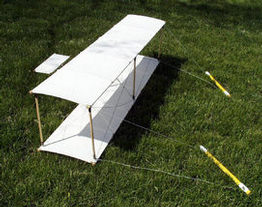
The Wright Kite is what kite flyers call a "quad" -- four
control lines, attached to two sticks. Angle one stick forward and
the other back to warp the wings. |

The tail is also movable and functions as an elevator.
Angle both sticks in the same direction to pitch the kite up or
down. For the initial flights, however, you should tighten the
bracing strings so the tail remains stationary. |

A close-up on the lower right corner of the kite, showing
how the struts are hinged to the spars with cotter pins. The cotter
pins are whip-lashed to the struts and spars. Not only does this
hold the hardware in place, it keeps the wood from
splintering. |
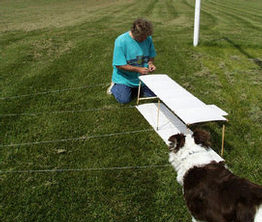
Before you fly the kite, you must make sure that all four
lines are precisely the same length. Keep them short -- no more than
10 feet long. Adjust the bracing strings so the tail is angled up
about 5 degrees. |
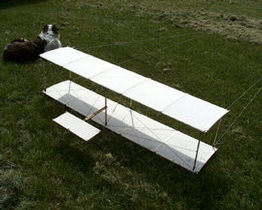
Here's the kite, ready to fly. If the wind is strong
enough, you can launch it from the ground by tugging on the two
bottom strings. In lighter winds, have someone hold it up as high as
possible and tug on the bottom strings. |
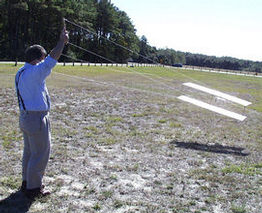
If the wind is steady, the kite will lift off just like an
airplane. Don't try to run with the kite -- it doesn't work. The
first few moments of flight are very squirrelly. You have only a few
seconds to get control. |

If you have trouble launching and getting control of the
kite, try shortening the strings. The longer the strings, the longer
the delay between your control movements and the time the kite
actually responds. |
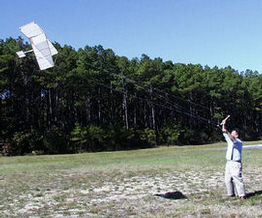
Here's how to roll the kite -- angle the control sticks in
opposite directions, Normally, you shouldn't have to angle them this
far. With a little practice, you can perform slow, gentle
rolls. |

However, the kite will rarely stay still in the
sky as it did for this one photo. It requires constant attention and
control inputs from you to keep it from crashing. |
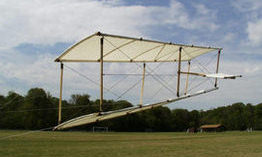
Once you're confident that you can roll the kite, loosen
the bracing strings so there's some play in them and you can rock
the wings back and forth by angling the control sticks in the same
direction. As the wings rock, the tail will go up or down. This, in
turn, will cause the kite to climb or descend. |
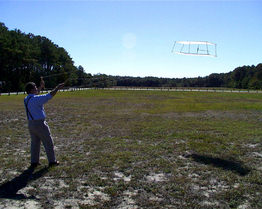
When you get the hang of this, you can fly the kite low to
the ground...
|
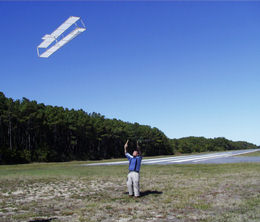
...or high in the air.
|